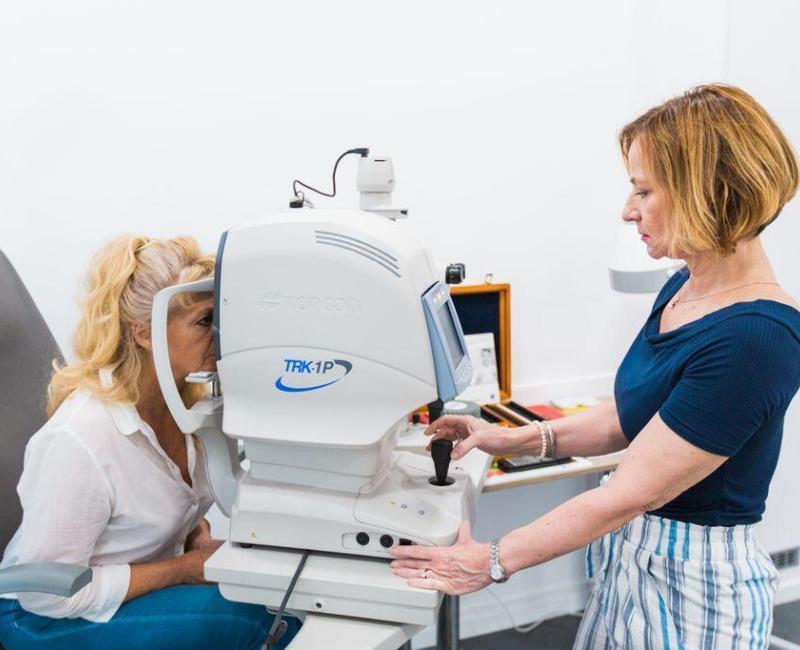
The pachymetry, i.e. the measurement of the thickness of the cornea, is always quick and completely painless, and is essential in the case of glaucoma. It can provide essential information for the ophthalmologist.
An eye pressure measurement using a non-contact tonometer, which is completely painless. The instrument does not touch your eyes during the test. An increase in intraocular pressure is responsible for the development of glaucoma in most cases. It can also cause other problems, but we often don’t realise that it could be the cause of our headaches, for example. It is also a good idea to check your eye pressure in several cases.
Normal eye pressure is responsible for the metabolism of the tissues in our eyes. This is maintained by the balance of aqueous humour, which is constantly being produced and drained away. If there is a problem in this process, the intraocular pressure changes. This in turn can be very dangerous for the functioning of our eyes, including our vision.
High intraocular pressure can be a sign of a serious condition such as diabetes or other endocrine problems, but it can also include high blood pressure and the possibility of vasoconstriction. It is therefore advisable to investigate what may be causing the change in eye pressure.
In addition, high eye pressure can cause blurred vision, coloured rings around lights and pain in the eye. In addition, it can also lead to loss of peripheral vision, visual impairment and visual field loss, all of which occur with the development of glaucoma.
In addition to the diseases mentioned above, high eye pressure can be caused by an eye infection, previous eye surgery or an eye injury. It can also be caused by high levels of myopia, but it can also be a side effect of medication, such as prolonged steroid therapy. Unfortunately, high levels of stress, smoking and excessive alcohol consumption can also be responsible for higher intraocular pressure. Lower eye pressure can be caused by an infection or dehydration. It can also be caused by spending too long in the sun.
We should also be aware that our eye pressure fluctuates constantly. The extent of this depends on our own sugar metabolism, but also on environmental factors such as sunshine. It can also be affected by exercise. Of course, this only affects our eye pressure temporarily – for minutes or days – and does not cause any visual problems.
As eye problems are more likely to occur over the age of 40, regular check-ups are recommended to prevent and detect eye problems early. This includes an eye pressure test.
This may be even more necessary if you have high blood pressure, or if you are a public health professional. If you already have high eye pressure, you should have your eye pressure checked regularly. It is also recommended for people with a family history of glaucoma, usually due to high eye pressure, and for anyone in any of the above risk groups.
At Rapidus Ophthalmology, intraocular pressure is measured using a non-contact tonometer. During this completely painless test, the eyes are not touched by the instrument and no anaesthetic is required.
During the test, air is blown into the eye for a moment to check the eye pressure. The force required to press down on a unit area of the cornea is also measured. All these data will help to determine whether the eye pressure shows any deviation from the normal. To obtain the best possible results, the test may need to be repeated several times and the average of the results obtained will be taken as the basis.
As the normal range of intraocular pressure can only be approximate, it is up to the individual to decide what is considered abnormal. To find out, however, further tests – such as fundus examination, visual field testing or OCT scans – may be necessary to get an accurate overall picture. If a patient’s intraocular pressure is causing visible problems or is in a cumulative risk group, any differences in intraocular pressure can be corrected with targeted treatment. This includes eye pressure reduction therapy, which can slow down or even stop the harmful processes if the problem is detected early enough.